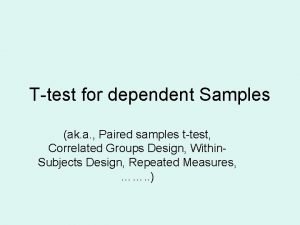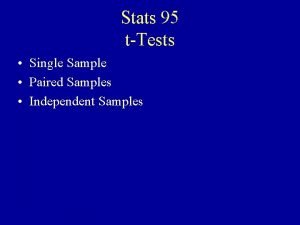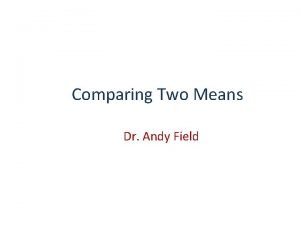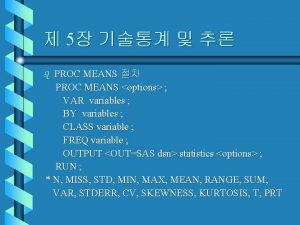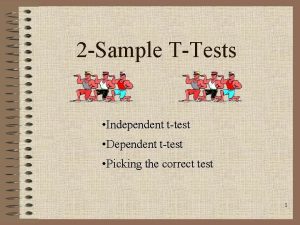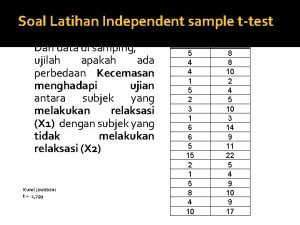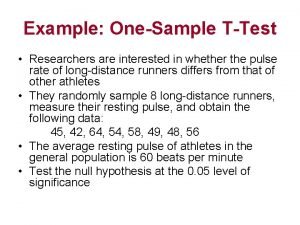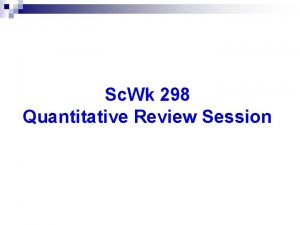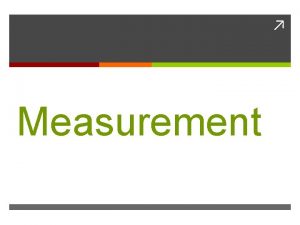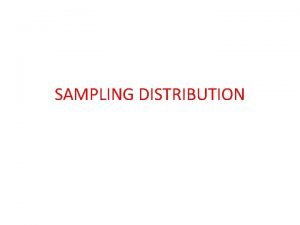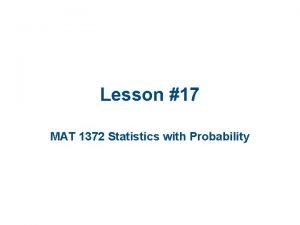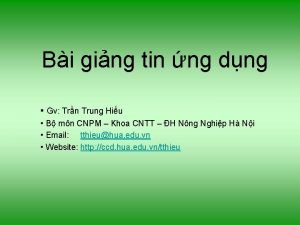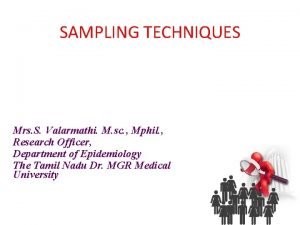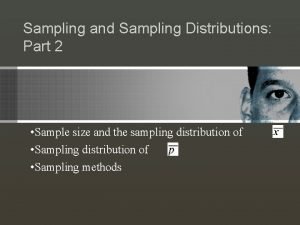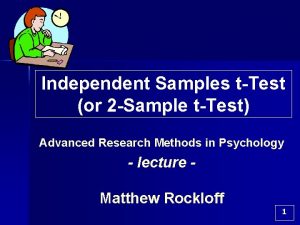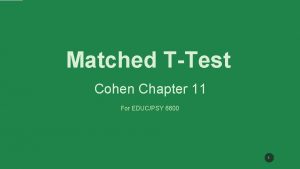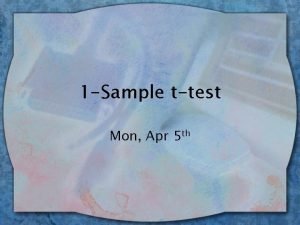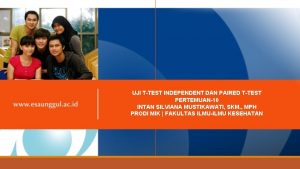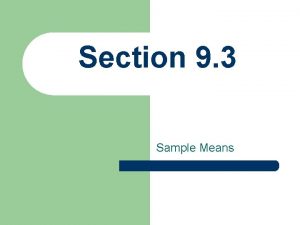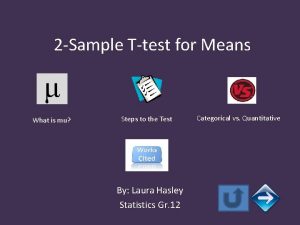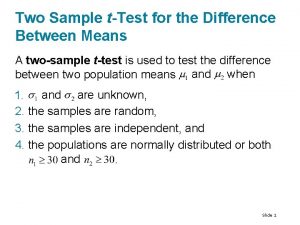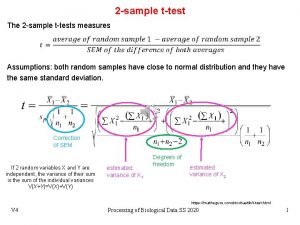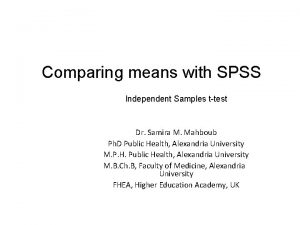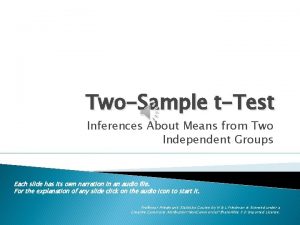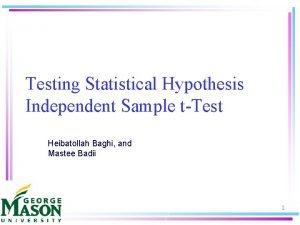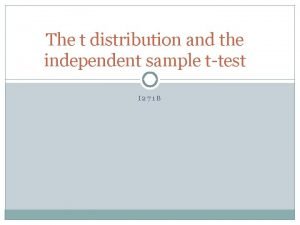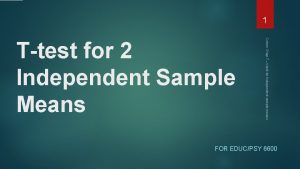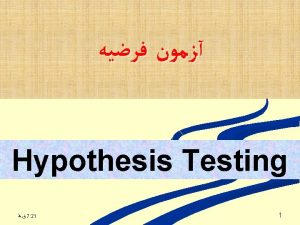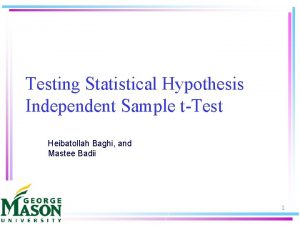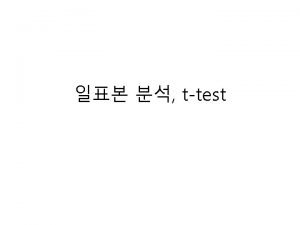TTEST FOR 2 INDEPENDENT SAMPLE MEANS For EDUCPSY





















- Slides: 21

T-TEST FOR 2 INDEPENDENT SAMPLE MEANS For EDUC/PSY 6600 COHEN CHAP 7 – T-TEST FOR INDEPENDENT SAMPLE MEANS 1

WE CANNOT SOLVE PROBLEMS BY USING THE SAME KIND OF THINKING THAT WE USED WHEN WE CREATED THEM. Albert Einstein COHEN CHAP 7 – T-TEST FOR INDEPENDENT SAMPLE MEANS 2

INTRO Same continuous DV compared across 2 independent (random) samples Is there a significant difference between the 2 group means? Do 2 samples come from different normal distributions with the same mean? aka… Independent-groups design Between-subjects design Between-groups design Randomized-groups design COHEN CHAP 7 – T-TEST FOR INDEPENDENT SAMPLE MEANS 3

STEPS OF A HYPOTHESIS TEST 1) State the Hypotheses (Null & Alternative) *even use z, if N > 100’ish 2) Select the Statistical Test & Significance Level • • α level One vs. Two tails 3) Select random samples and collect data 4) Find the region of Rejection • Based on α & # of tails 5) Calculate the Test Statistic • Examples include: z, t, F, χ2 6) Make the Statistical Decision 4

STEPS OF A HYPOTHESIS TEST 1) State the Hypotheses (Null & Alternative) 2) Select the Statistical Test & Significance Level • • α level One vs. Two tails 3) Select random samples and collect data 4) Find the region of Rejection • Based on α & # of tails 5) Calculate the Test Statistic Examples include: z, t, F, χ2 6) Make the Statistical Decision

COHEN CHAP 7 – T-TEST FOR INDEPENDENT SAMPLE MEANS 6

EXAMPLE 1 In order to assess the efficacy of a new antidepressant drug, 10 clinically depressed participants are randomly assigned to one of two groups. Five participants are assigned to Group 1, which is administered the antidepressant drug for 6 months. The other 5 participants are assigned to Group 2, which is administered a placebo during the same 6 month period Assume that prior to introducing the treatments, the experimenter confirmed that the level of depression in the 2 groups was equal After 6 months, all participants are rated by a psychiatrist (blind to participant assignment) on their level of depression 7

EXAMPLE 1 8

EXAMPLE 1 - OUTPUT 9

EXAMPLE 1 – T-TEST COHEN CHAP 7 – T-TEST FOR INDEPENDENT SAMPLE MEANS 10

EXAMPLE 1 After 6 months, the five participants taking the drug scored numerically lower on the depression scale (M = 2. 80, SD = 4. 66), compared their five counter parts taking placebo (M = 7. 80, SD = 3. 27). To test the effectiveness of the drug at reducing depression, an independent samples t-test was performed. The distribution of depression scores were sufficiently normal for the purposes of conducting a t-test (i. e. skew < |2. 0| and kurtosis < |9. 0|; Schmider, Sigler, Danay, Beyer, & Buhner, 2010). Additionally, the assumption of homogeneity of variances was tested and satisfied via Levene’s F-test, F(1, 8) =. 08, p =. 782. The independent samples t-test did not find a statistically significant effect, t(8) = -1. 796, p =. 110. Thus, there is no evidence this drug reduces depression. 11

ASSUMPTIONS (SIMILAR TO 1 -SAMPLE T -TESTS) 1. BOTH Samples were drawn INDEPENDENTLY at random (at least as representative as possible) Nothing can be done to fix NON-representative samples! Can not statistically test…violation: paired-samples t-test 2. The variable has a NORMAL distribution, for BOTH population Not as important if the sample is large (Central Limit Theorem) IF the sample is far from normal &/or small n, might want to transform variables Look at plots: histogram, boxplot, & QQ plot (straight 45º line) sensitive to outliers!!! Skewness & Kurtosis: Divided value by its SE & > ± 2 indicates issues Shapiro-Wilks test (small N): p <. 05 not normal Kolmogorov-Smirnov test (large N): 3. HOV = Homogeneity of Variance: BOTH populations have the sample spread use Levene’s F-test (null= HOV) 12

RANDOM ASSIGNMENT Random assignment to groups ↓ experimenter biases Cases are enumerated Numbers drawn and assigned to group in any of several ways Does not ensure equality of group characteristics Experiment: Random assignment & manipulation of IV Treatment vs. control or 2 treatment groups Quasi-experiment: Either randomization or manipulation Non-experiment: Neither randomization or manipulation Participants self-select or form naturally occurring groups COHEN CHAP 7 – T-TEST FOR INDEPENDENT SAMPLE MEANS 13

VIOLATIONS OF ASSUMPTIONS Equal groups: Violations ‘hurt’ less Heterogeneity of variance Small effects, p-value inaccurate ±. 02 Non-normality Small effects, p-value inaccurate ±. 02 However: If samples are highly skewed or are skewed in opposite directions p-values can be *very* inaccurate Both Moderate effects if N is large, p-value can be inaccurate Large effects if N is small, p-value can be *very* inaccurate COHEN CHAP 7 – T-TEST FOR INDEPENDENT SAMPLE MEANS 14

VIOLATIONS OF ASSUMPTIONS Unequal groups: Violations ‘hurt’ more Heterogeneity of variance Large effects Non-normality Large effects Both Huge effects p-values can be **very** inaccurate with unequal ns and violations of assumptions, especially when N is small COHEN CHAP 7 – T-TEST FOR INDEPENDENT SAMPLE MEANS 15

ALTERNATIVES (ASSUMPTIONS VIOLATED) Violation of normality or ordinal DV Two Sample Wilcoxon test (aka, Mann-Whitney U Test) Sample re-use methods Rely on empirical, rather than theoretical, probability distributions Exact statistical methods Permutation and randomization tests Bootstrapping COHEN CHAP 7 – T-TEST FOR INDEPENDENT SAMPLE MEANS 16

CONFIDENCE INTERVALS 95% CI for difference between means: μ 1 - μ 2 Rearrange independent-samples t-test formula Estimation as NHST (Null hypothesis Significance Test) If H 0: μ 1 = μ 2 and if CI does NOT contain 0, reject H 0 If H 0: μ 1 = μ 2 and if CI does contain 0, fail to reject H 0 Compute for in-class example COHEN CHAP 7 – T-TEST FOR INDEPENDENT SAMPLE MEANS 17

EXAMPLE 2 An industrial psychologist is investigation the effects of different types of motivation on the performance of simulated clerical tasks. The 10 participants in the “individual motivation” sample are told that they will be rewarded according to how many tasks they successfully complete. The 12 participants in the “group motivation” sample are told that they will be rewarded according to the average number of tasks completed by all the participants in their sample. The number of tasks completed by each participant are as follows: Individual Motivation: Group Motivation: 11, 17, 14, 12, 11, 15, 13, 12, 15, 16 10, 15, 4, 8, 9, 14, 6, 15, 7, 11, 13, 5 ## data object is df 2_long %>% dplyr: : group_by(group) %>% furniture: : table 1(value) ────────────── group Individual Group n = 10 n = 12 value 13. 6 (2. 1) 9. 8 (3. 9) ────────────── 18

EXAMPLE 2 library(tidyverse) library(furniture) ## our data object is df 2_long ## Check boxplots df 2_long %>% ggplot(aes(x = group, y = value)) + geom_boxplot() COHEN CHAP 7 – T-TEST FOR INDEPENDENT SAMPLE MEANS 19

EXAMPLE 2 df 2_long %>% car: : levene. Test(value ~ group, data =. , center = "mean") #> Levene's Test for Homogeneity of Variance (center = "mean") #> Df F value Pr(>F) #> group 1 4. 8287 0. 03994 * #> 20 df 2_long %>% t. test(value ~ group, data =. , var. equal = FALSE) #> #> #> Welch Two Sample t-test data: value by group t = 2. 9456, df = 17. 518, p-value = 0. 008833 alternative hypothesis: true difference in means is not equal to 0 95 percent confidence interval: 1. 098587 6. 601413 sample estimates: mean in group 1 mean in group 2 13. 60 9. 75 COHEN CHAP 7 – T-TEST FOR INDEPENDENT SAMPLE MEANS 20

EXAMPLE 2 #> Levene's Test for Homogeneity of Variance (center = "mean") #> Df F value Pr(>F) #> group 1 4. 8287 0. 03994 * #> 20 #> #> Welch Two Sample t-test data: value by group t = 2. 9456, df = 17. 518, p-value = 0. 008833 alternative hypothesis: true difference in means is not equal to 0 95 percent confidence interval: 1. 098587 6. 601413 sample estimates: mean in group 1 mean in group 2 13. 60 9. 75 The number of tasks completed was numerically higher among the individually motivated group (n = 10, M = 13. 60, SD = 2. 12), compared to the individuals being motivated by the groups results (n = 12, M = 9. 75, SD = 3. 89). To test the difference in mean productivity, an independent samples t-test was performed. The distribution of depression scores were sufficiently normal for the purposes of conducting a t-test (i. e. skew < |2. 0| and kertosis < |9. 0|; Schmider, Sigler, Danay, Beyer, & Buhner, 2010). Additionally, the assumption of homogeneity of variances was tested and rejected via Levene’s F-test, F(9, 11) = 4. 829, p =. 040. The independent samples, separate variances t-test found a statistically significant effect, t(17. 52) = 2. 946, p =. 009. Thus, individual motivation does result in a mean 3. 85 additional tasks completed compared to group motivation (95% CI: [1. 01, 6. 60]). 21
 Independent t test example
Independent t test example Paired sample t-test formula
Paired sample t-test formula Effect size for t-test
Effect size for t-test Graphpad ttest
Graphpad ttest T-test beispielrechnung
T-test beispielrechnung Proc ttest
Proc ttest Ttest ind
Ttest ind Independent clause fanboys independent clause
Independent clause fanboys independent clause Contoh soal dan jawaban independent sample t test
Contoh soal dan jawaban independent sample t test Difference between independent and one sample t test
Difference between independent and one sample t test Two independent sample t test spss
Two independent sample t test spss Poly and gon
Poly and gon Metamorphic rocks
Metamorphic rocks Meta means in metamorphism
Meta means in metamorphism Biodiversity conservation meaning
Biodiversity conservation meaning Bio means life logy means
Bio means life logy means How to solve sampling distribution of sample means
How to solve sampling distribution of sample means Construct the sampling distribution of the sample means
Construct the sampling distribution of the sample means Z test two sample for means
Z test two sample for means Advantages of sampling
Advantages of sampling Convenience sampling images
Convenience sampling images Volunteer sample vs convenience sample
Volunteer sample vs convenience sample
